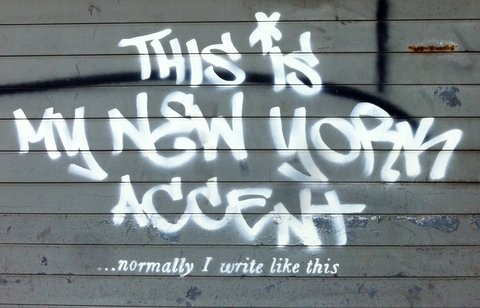
The street artist Banksy is all over the news lately–or at least he’s been there since October 1st, when he began a thirty day stint of public art projects in the New York City area. We’ve mentioned him before on Mbird, including his Exit Through the Gift Shop, with a particular interested in the ueber-creative, borderline absurd prophetic law-voice that pervades his work. You’ve probably seen his trademark stencil-based-style and tongue-in-cheek dark humor before, and if you haven’t, here are some of our favorites.
Since we last caught up with Banksy, a strange thing has happened to his subversive persona. In an odd turn of events, the very lifestyles and social circles Banksy sought to critique began clamoring for his art in a serious way. His pieces have become the talk of many art circles, fetching ridiculous prices at auction. Seriously, Banksy paintings are reaching the million dollar mark on the art market. If your art trends toward anti-capitalistic, anti-greed social commentary, and the targets of your criticism clamor to integrate you into their hip social circles, there’s something of a cognitive dissonance to work out. “There’s no way round it – commercial success is a mark of failure for a graffiti artist,” he told a newspaper in a recent interview. It’s like the ancient kings of Israel inviting a prophet to a royal dinner- “yes, come eat dinner with us and say more about this law-breaking thing and how God’s going to judge us–my guests from the next kingdom over will get a total kick out of it!”
Hence, the mind bending display this past Saturday where Banksy sold a few dozen pieces for $60 on a sidewalk in Central Park:
Talk about your “pearls before swine!” Art lovers could have had their very own red hot art status symbol for a mere $60–or even for half that price if you’re into haggling! One BBC estimate valued these paintings at nearly $30,000 if they were turned around and sold in a gallery. What a small price to pay for street cred that will last you for decades–and only three lucky patrons took advantage of the sale. (Note: I’m reminded of the 2012 Mbird NYC conference where the language of luck was discussed as a synonym for grace.)
This whole stunt drew up some real emotions in me–similar to the somewhat infamous story of virtuoso violinist Josh Bell playing a free show during rush hour at a D.C. Metro stop. Would I stop my morning commute and listen to the virtuoso violinist? Would I recognize world-class art if it was sold on a NYC sidewalk, or any city sidewalk for that matter? Part of me would play the skeptic, of course–surely these aren’t real Banksy pieces, are they? But alas, I’m also too poor to afford even a $60 Banksy, so I would have been excluded from the experiment anyway.
I couldn’t quite put a name to my emotional response until I read about the followup fake Banksy art sale that took place:
A few other artists play prankster and sell knock-off Banksy pieces for the same price–complete with notarized certificates of non-authenticity–and they sell out within an hour. It’s a story dripping with irony, the law of coolness, and ultimately, the ever dreaded Fear of Missing Out. After the widely publicized Banksy stunt, art lovers kept their eyes peeled for the new great thing, and this sale might have been it–could the infamous street artist be double-pulling our legs, selling his “fakes” as the real thing? Better to be safe than sorry, better to invest instead of missing out on the next covert goldmine. And even with a fake, it still makes for a great story.
FOMO strikes again, both in me and in New York City’s art scene, to where investing in certified fake art becomes a way of entering in on the zeitgeist. The prankster/vandal/artist has played his hand marvelously, exposing the faultiness of the human heart and the institutions it creates, while inspiring anxiety in those interested in maintaining their identities as aesthetic authorities.
So bravo to Banksy for so publicly being the law in a world so allergic to it–for exposing the human need for self-justification through owning his work. And bravo for Banksy for exposing that same fear within me too.

COMMENTS
One response to “Banksy, FOMO, and the Hippest Law in NYC”
Leave a Reply














Style and cool are commodities, and have been for a good long time–and so is every highly visible form of the “prophetic” critique of same. Banksy has entered into this game willingly–if it were not so, he wouldn’t have done a Simpsons opening. So for all the posturing, he’s merely a trendier and more expensive Che t-shirt. It’s not like he came out of this somehow LESS commercially viable. Subversive? Not remotely.
That said, it’s interesting to think that all we have are compromised prophets and hypocritical preachers–that fits a God who refuses to show himself to us in purity, but only clothed in our own sin.